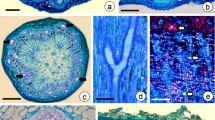Summary
Light- and electron-microscopic observations on the cornicles of the rose aphid Macrosiphum rosae are presented, and discussed in relation to conflicting interpretations of cornicle structure and function. Lipid filled cornicle secretory cells occupy the lumen of the cornicle and extend into the abdominal cavity. The aphid is readily induced by mechanical stimuli to release cornicle secretory cells from a pore at the tip of the cornicle. The holocrine secretory cells are disrupted and release their lipid contents on leaving the body. They are enclosed within an acellular membranous sac that is apparently identical in structure with the basal lamina of the epidermis. The ultrastructure and anatomical relationships of the cornicle secretory cells suggest that they are oenocytes invaginated with the epidermal basal lamina, and are not anatomically or embryologically related to fat body.
Similar content being viewed by others
References
Dixon, A. F. G.: The escape responses shown by certain aphids to the presence of the coccinellid Adalia decempunctata (L.). Trans. Roy. Ent. Soc. (Lond.) 110, 319–334 (1958).
Edwards, J. S.: Defense by smear: Supercooling in the cornicle wax of aphids. Nature (Lond.) 211, 73–74 (1966).
Hottes, F. C.: Concerning the structure, function and origin of the cornicles of the Family Aphididae. Proc. Biol. Soc. Wash. 41, 71–84 (1928).
Lindsay, K. L.: Cornicles of the Pea Aphid, Acyrthosiphon pisum; their structure and function. A light and electron microscope study. Ann. entomol. Soc. Amer. 62, 1015–1021 (1969).
Luft, J. H.: Improvements in epoxy resin embedding methods. J. biophys. biochem. Cytol. 9, 409 (1961).
Reynolds, E. S.: The use of lead citrate at high pH as an electron-opaque stain in electron microscopy. J. Cell Biol. 17, 208 (1963).
Strong, F. E.: Observations on aphid cornicle secretions. Ann. entomol. Soc. Amer. 60 (3), 668–673 (1967).
Wigglesworth, V. B.: The principles of insect physiology, 6th ed. London: Methuen & Co. Ltd. 1965.
Author information
Authors and Affiliations
Additional information
We thank Mr. Arnold G. Schmidt, Department of Mining, Metallurgy and Ceramic Engineering of the University of Washington, Seattle, for assistance with scanning microscopy, Miss Louise M. Russell, Insect Identification Section, Entomology Research Division, Beltsville, Maryland for identifying the aphid and Dr. Richard A. Cloney for commenting on the manuscript.
Rights and permissions
About this article
Cite this article
Chen, SW., Edwards, J.S. Observations on the structure of secretory cells associated with aphid cornicles. Z.Zellforsch 130, 312–317 (1972). https://doi.org/10.1007/BF00306945
Received:
Issue Date:
DOI: https://doi.org/10.1007/BF00306945




